MITSUBISHI L200 2015 Owner's Manual (in English)
Manufacturer: MITSUBISHI, Model Year: 2015, Model line: L200, Model: MITSUBISHI L200 2015Pages: 418, PDF Size: 25.8 MB
Page 311 of 418
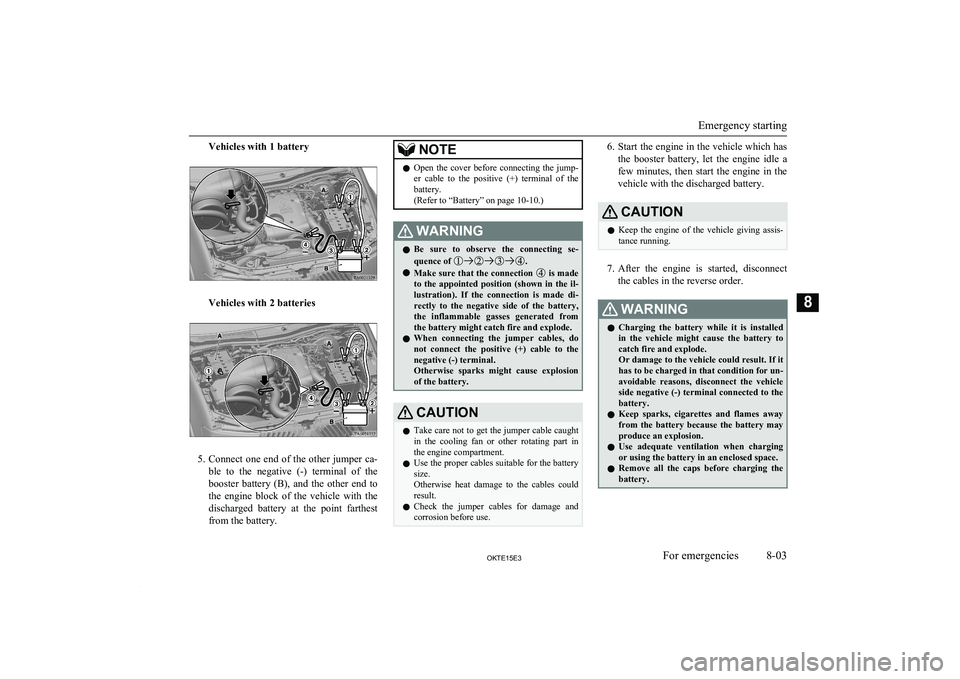
Vehicles with 1 battery
Vehicles with 2 batteries
5.Connect one end of the other jumper ca-
ble to the negative (-) terminal of the
booster battery (B), and the other end to
the engine block of the vehicle with the
discharged battery at the point farthest from the battery.
NOTEl Open the cover before connecting the jump-
er cable to the positive (+) terminal of thebattery.
(Refer to “Battery” on page 10-10.)WARNINGl Be sure to observe the connecting se-
quence of .
l Make sure that the connection
is made
to the appointed position (shown in the il-
lustration). If the connection is made di-
rectly to the negative side of the battery, the inflammable gasses generated from the battery might catch fire and explode.
l When connecting the jumper cables, do
not connect the positive (+) cable to the
negative (-) terminal.
Otherwise sparks might cause explosion
of the battery.
CAUTIONl Take care not to get the jumper cable caught
in the cooling fan or other rotating part in
the engine compartment.
l Use the proper cables suitable for the battery
size.
Otherwise heat damage to the cables could
result.
l Check the jumper cables for damage and
corrosion before use.6. Start the engine in the vehicle which has
the booster battery, let the engine idle a
few minutes, then start the engine in the vehicle with the discharged battery.CAUTIONl Keep the engine of the vehicle giving assis-
tance running.
7. After the engine is started, disconnect
the cables in the reverse order.
WARNINGl Charging the battery while it is installed
in the vehicle might cause the battery to
catch fire and explode.
Or damage to the vehicle could result. If it has to be charged in that condition for un- avoidable reasons, disconnect the vehicle
side negative (-) terminal connected to the
battery.
l Keep sparks, cigarettes and flames away
from the battery because the battery may
produce an explosion.
l Use adequate ventilation when charging
or using the battery in an enclosed space.
l Remove all the caps before charging the
battery.
Emergency starting
8-03OKTE15E3For emergencies8
Page 312 of 418
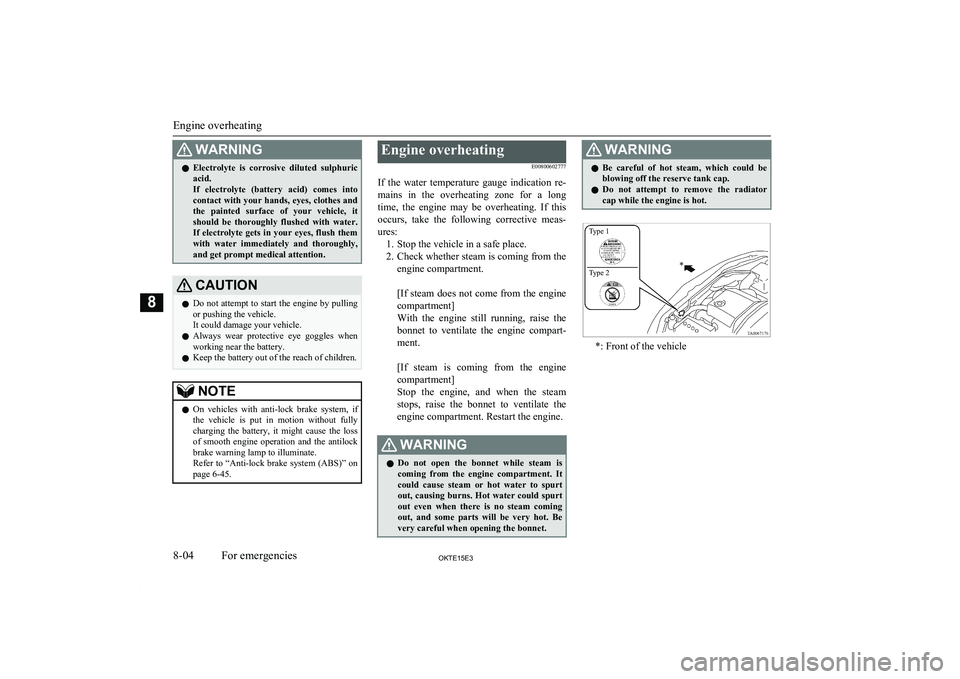
WARNINGlElectrolyte is corrosive diluted sulphuric
acid.
If electrolyte (battery acid) comes into contact with your hands, eyes, clothes and
the painted surface of your vehicle, it should be thoroughly flushed with water.If electrolyte gets in your eyes, flush them
with water immediately and thoroughly, and get prompt medical attention.CAUTIONl Do not attempt to start the engine by pulling
or pushing the vehicle.
It could damage your vehicle.
l Always wear protective eye goggles when
working near the battery.
l Keep the battery out of the reach of children.NOTEl
On vehicles with anti-lock brake system, if
the vehicle is put in motion without fully charging the battery, it might cause the loss
of smooth engine operation and the antilock brake warning lamp to illuminate.
Refer to “Anti-lock brake system (ABS)” on
page 6-45.Engine overheating
E00800602777
If the water temperature gauge indication re-
mains in the overheating zone for a long
time, the engine may be overheating. If this occurs, take the following corrective meas-
ures: 1. Stop the vehicle in a safe place.
2. Check whether steam is coming from the
engine compartment.
[If steam does not come from the engine
compartment]
With the engine still running, raise the bonnet to ventilate the engine compart-
ment.
[If steam is coming from the engine
compartment]
Stop the engine, and when the steam
stops, raise the bonnet to ventilate the engine compartment. Restart the engine.WARNINGl Do not open the bonnet while steam is
coming from the engine compartment. It
could cause steam or hot water to spurt out, causing burns. Hot water could spurt
out even when there is no steam coming out, and some parts will be very hot. Be
very careful when opening the bonnet.WARNINGl Be careful of hot steam, which could be
blowing off the reserve tank cap.
l Do not attempt to remove the radiator
cap while the engine is hot.
*: Front of the vehicle
Engine overheating
8-04OKTE15E3For emergencies8 Type 1
Type 2
Page 313 of 418
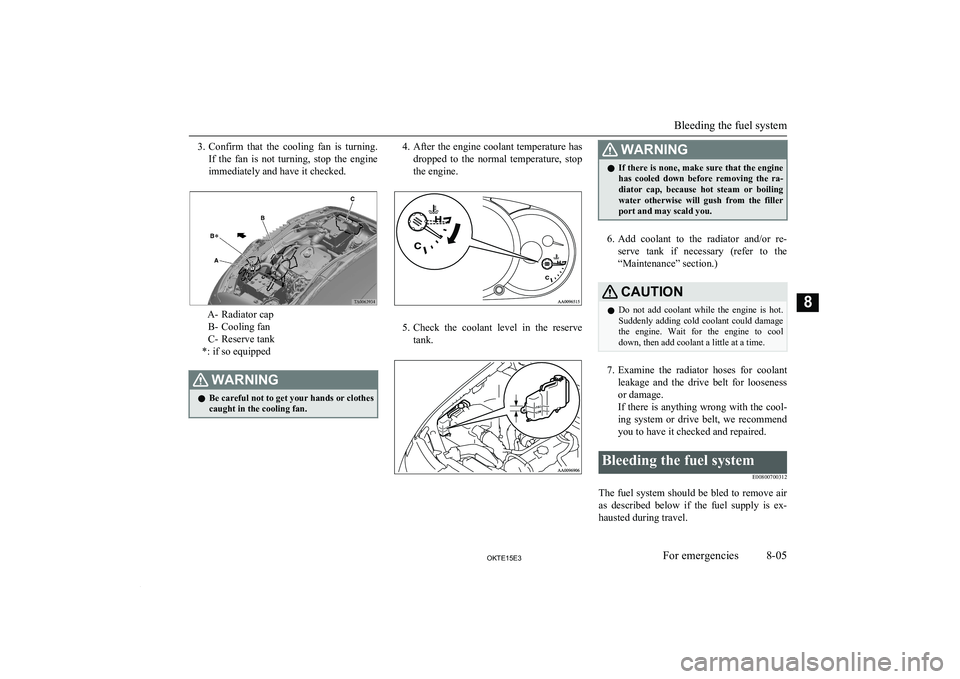
3.Confirm that the cooling fan is turning.
If the fan is not turning, stop the engine
immediately and have it checked.
A- Radiator cap B- Cooling fan
C- Reserve tank
*: if so equipped
WARNINGl Be careful not to get your hands or clothes
caught in the cooling fan.4. After the engine coolant temperature has
dropped to the normal temperature, stop the engine.
5. Check the coolant level in the reserve
tank.
WARNINGl If there is none, make sure that the engine
has cooled down before removing the ra-
diator cap, because hot steam or boiling water otherwise will gush from the fillerport and may scald you.
6. Add coolant to the radiator and/or re-
serve tank if necessary (refer to the
“Maintenance” section.)
CAUTIONl Do not add coolant while the engine is hot.
Suddenly adding cold coolant could damage
the engine. Wait for the engine to cool
down, then add coolant a little at a time.
7. Examine the radiator hoses for coolant
leakage and the drive belt for looseness
or damage.
If there is anything wrong with the cool-
ing system or drive belt, we recommend
you to have it checked and repaired.
Bleeding the fuel system
E00800700312
The fuel system should be bled to remove air
as described below if the fuel supply is ex- hausted during travel.
Bleeding the fuel system
8-05OKTE15E3For emergencies8
Page 314 of 418
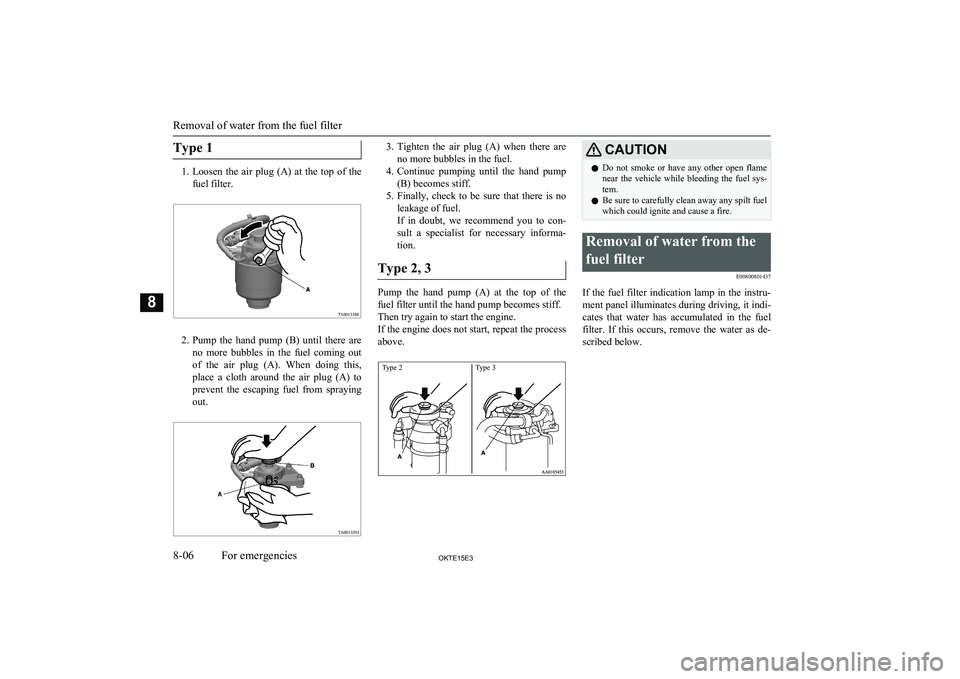
Type 1
1.Loosen the air plug (A) at the top of the
fuel filter.
2. Pump the hand pump (B) until there are
no more bubbles in the fuel coming out
of the air plug (A). When doing this, place a cloth around the air plug (A) toprevent the escaping fuel from spraying
out.
3. Tighten the air plug (A) when there are
no more bubbles in the fuel.
4. Continue pumping until the hand pump
(B) becomes stiff.
5. Finally, check to be sure that there is no
leakage of fuel.
If in doubt, we recommend you to con-
sult a specialist for necessary informa- tion.
Type 2, 3
Pump the hand pump (A) at the top of the fuel filter until the hand pump becomes stiff.Then try again to start the engine.
If the engine does not start, repeat the process
above.
Type 2Type 3
CAUTIONl Do not smoke or have any other open flame
near the vehicle while bleeding the fuel sys-
tem.
l Be sure to carefully clean away any spilt fuel
which could ignite and cause a fire.Removal of water from the
fuel filter E00800801437
If the fuel filter indication lamp in the instru-ment panel illuminates during driving, it indi-
cates that water has accumulated in the fuel filter. If this occurs, remove the water as de-
scribed below.
Removal of water from the fuel filter
8-06OKTE15E3For emergencies8
Page 315 of 418
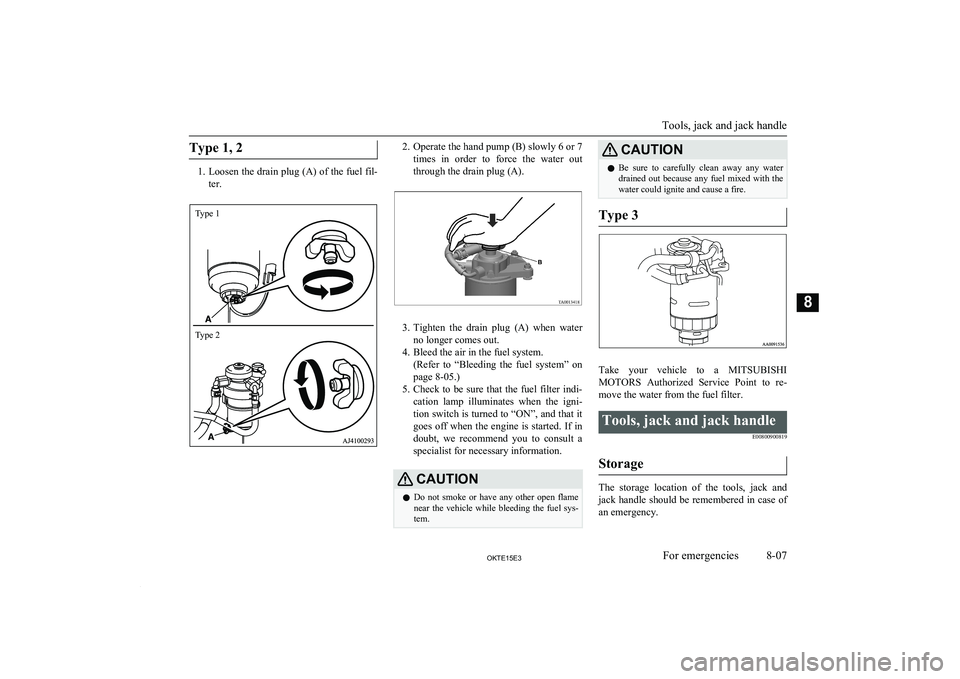
Type 1, 2
1.Loosen the drain plug (A) of the fuel fil-
ter.
2. Operate the hand pump (B) slowly 6 or 7
times in order to force the water out
through the drain plug (A).
3. Tighten the drain plug (A) when water
no longer comes out.
4. Bleed the air in the fuel system. (Refer to “Bleeding the fuel system” onpage 8-05.)
5. Check to be sure that the fuel filter indi-
cation lamp illuminates when the igni- tion switch is turned to “ON”, and that it
goes off when the engine is started. If in
doubt, we recommend you to consult a specialist for necessary information.
CAUTIONl Do not smoke or have any other open flame
near the vehicle while bleeding the fuel sys- tem.CAUTIONl Be sure to carefully clean away any water
drained out because any fuel mixed with the
water could ignite and cause a fire.
Type 3
Take your vehicle to a MITSUBISHI
MOTORS Authorized Service Point to re-
move the water from the fuel filter.
Tools, jack and jack handle
E00800900819
Storage
The storage location of the tools, jack andjack handle should be remembered in case ofan emergency.
Tools, jack and jack handle
8-07OKTE15E3For emergencies8Type 1
Type 2
Page 316 of 418
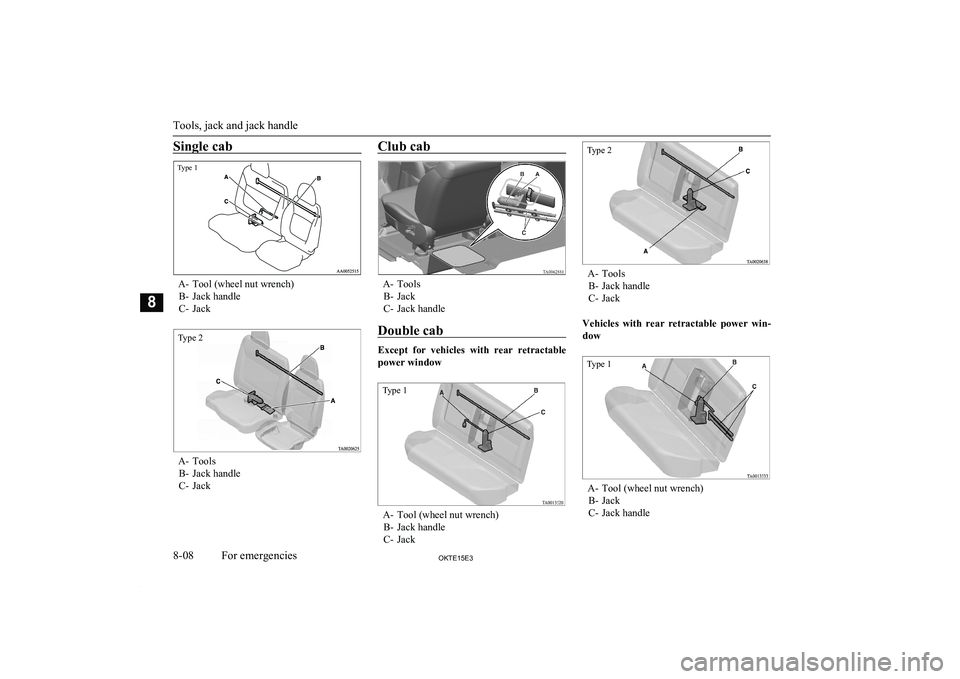
Single cabType 1
A- Tool (wheel nut wrench)B- Jack handle
C- Jack
A- Tools B- Jack handle
C- Jack
Club cab
A- Tools B- Jack
C- Jack handle
Double cab
Except for vehicles with rear retractable
power window
A- Tool (wheel nut wrench) B- Jack handle
C- Jack
A- Tools
B- Jack handle
C- Jack
Vehicles with rear retractable power win-
dow
A- Tool (wheel nut wrench) B- Jack
C- Jack handle
Tools, jack and jack handle
8-08OKTE15E3For emergencies8Type 2 Type 1 Type 2 Type 1
Page 317 of 418
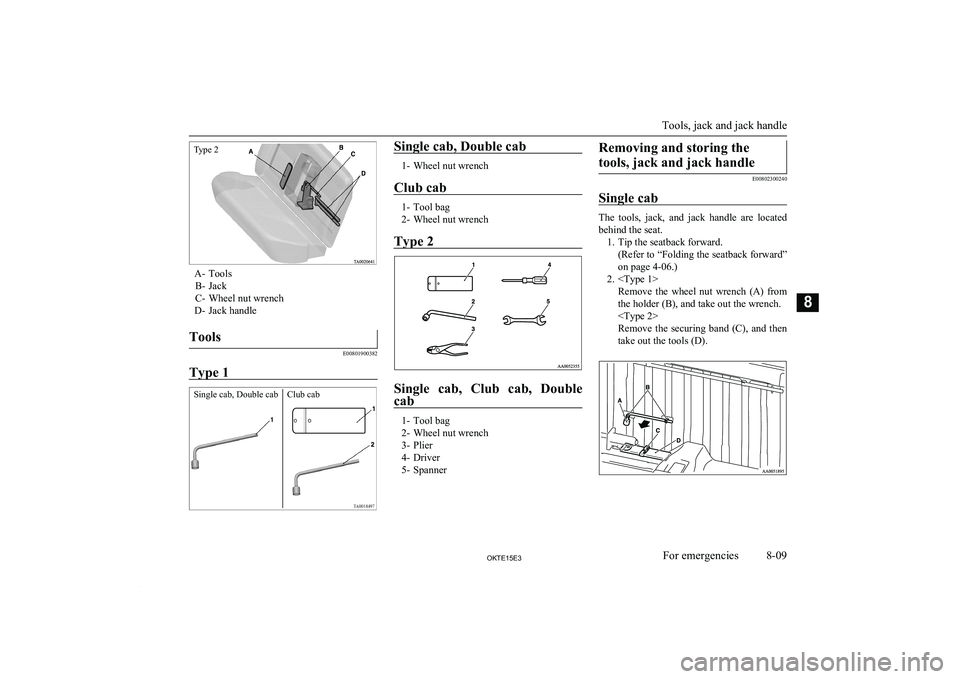
A- ToolsB- Jack
C- Wheel nut wrench
D- Jack handle
Tools
E00801900382
Type 1
Single cab, Double cab
1- Wheel nut wrench
Club cab
1- Tool bag
2- Wheel nut wrench
Type 2
Single cab, Club cab, Double cab
1- Tool bag
2- Wheel nut wrench
3- Plier
4- Driver
5- Spanner
Removing and storing the
tools, jack and jack handle
E00802300240
Single cab
The tools, jack, and jack handle are located
behind the seat. 1. Tip the seatback forward. (Refer to “Folding the seatback forward”
on page 4-06.)
2.
Remove the securing band (C), and then
take out the tools (D).
Tools, jack and jack handle
8-09OKTE15E3For emergencies8Type 2 Single cab, Double cab Club cab
Page 318 of 418
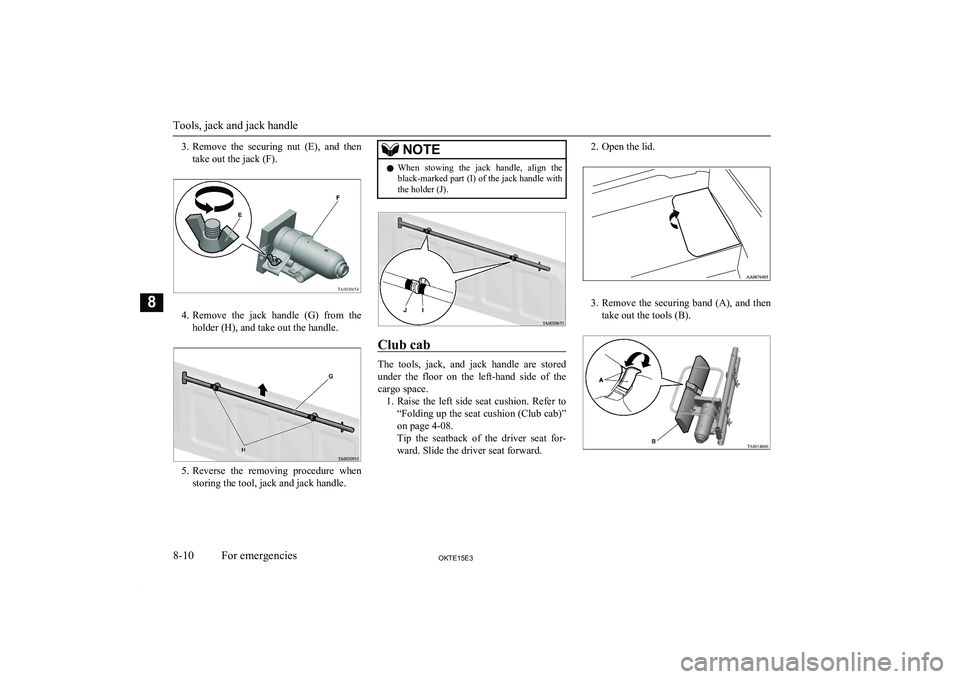
3.Remove the securing nut (E), and then
take out the jack (F).
4. Remove the jack handle (G) from the
holder (H), and take out the handle.
5. Reverse the removing procedure when
storing the tool, jack and jack handle.
NOTEl When stowing the jack handle, align the
black-marked part (I) of the jack handle with
the holder (J).
Club cab
The tools, jack, and jack handle are stored
under the floor on the left-hand side of the
cargo space. 1. Raise the left side seat cushion. Refer to
“Folding up the seat cushion (Club cab)”
on page 4-08.
Tip the seatback of the driver seat for- ward. Slide the driver seat forward.
2. Open the lid.
3. Remove the securing band (A), and then
take out the tools (B).
Tools, jack and jack handle
8-10OKTE15E3For emergencies8
Page 319 of 418
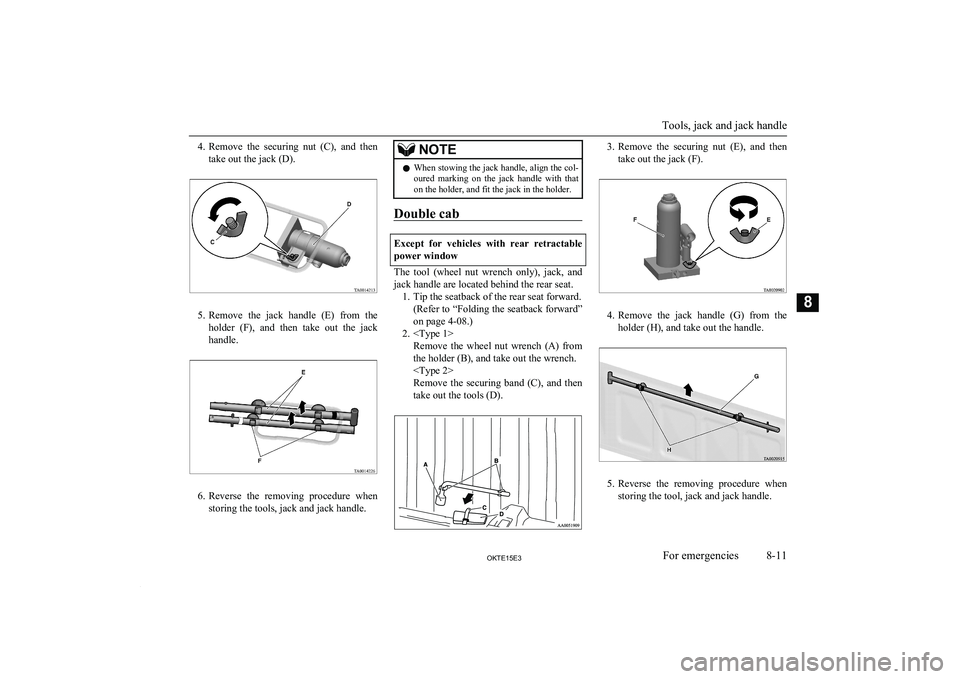
4.Remove the securing nut (C), and then
take out the jack (D).
5. Remove the jack handle (E) from the
holder (F), and then take out the jack
handle.
6. Reverse the removing procedure when
storing the tools, jack and jack handle.
NOTEl When stowing the jack handle, align the col-
oured marking on the jack handle with that
on the holder, and fit the jack in the holder.
Double cab
Except for vehicles with rear retractable
power window
The tool (wheel nut wrench only), jack, and jack handle are located behind the rear seat. 1. Tip the seatback of the rear seat forward. (Refer to “Folding the seatback forward”
on page 4-08.)
2.
Remove the securing band (C), and then
take out the tools (D).
3. Remove the securing nut (E), and then
take out the jack (F).
4. Remove the jack handle (G) from the
holder (H), and take out the handle.
5. Reverse the removing procedure when
storing the tool, jack and jack handle.
Tools, jack and jack handle
8-11OKTE15E3For emergencies8
Page 320 of 418
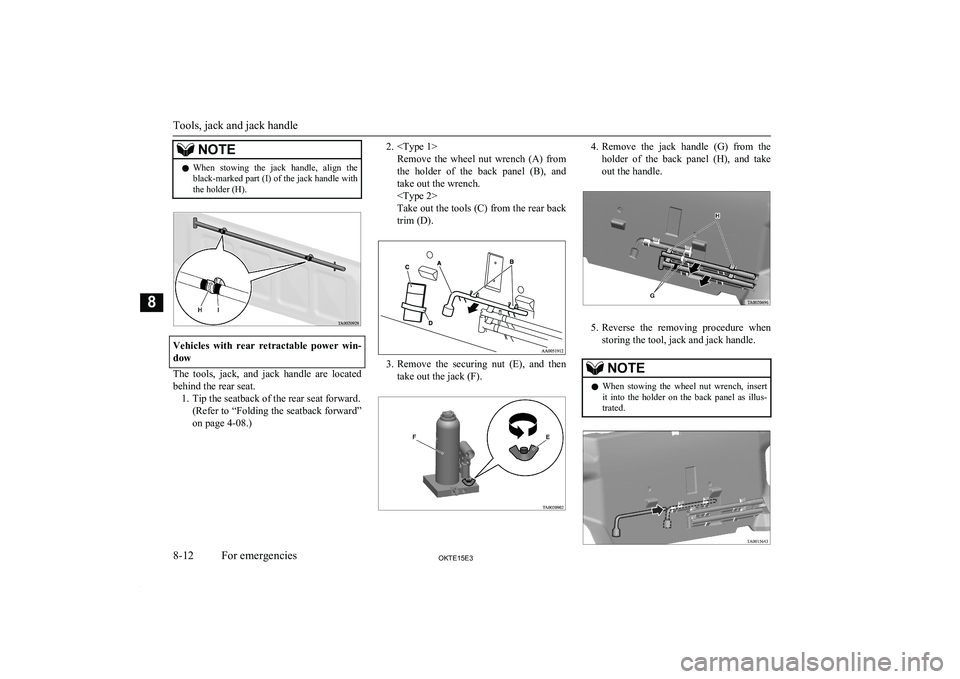
NOTElWhen stowing the jack handle, align the
black-marked part (I) of the jack handle with
the holder (H).
Vehicles with rear retractable power win-
dow
The tools, jack, and jack handle are located
behind the rear seat. 1. Tip the seatback of the rear seat forward. (Refer to “Folding the seatback forward”
on page 4-08.)
2.
Remove the wheel nut wrench (A) fromthe holder of the back panel (B), and
take out the wrench.
Take out the tools (C) from the rear back trim (D).
3. Remove the securing nut (E), and then
take out the jack (F).
4. Remove the jack handle (G) from the
holder of the back panel (H), and take
out the handle.
5. Reverse the removing procedure when
storing the tool, jack and jack handle.
NOTEl When stowing the wheel nut wrench, insert
it into the holder on the back panel as illus-
trated.
Tools, jack and jack handle
8-12OKTE15E3For emergencies8